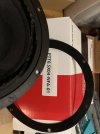After replacing the wood screws with machine screws with nutserts, the improvements were more marginal than I expected. Have not yet tried the passive radiator, but suspect it needs more given its stamped steel frame. Since I have the speaker on my bench, decided to see what I might do to help with the 380 Hz resonance in the driver frame. Purifi mentioned some potential remediation on their part but am using an older woofer and it has the admitted resonance. Since the brace conveniently runs behind the woofer, was able to try many different materials and techniques to improve.
I tried wood bracing, rubber gasketing, sonic barrier and some CLD layering with some of them. Also tried adding a large mass of butyl rubber to the frame (no major effect). As will show, the improvements are incremental and a few dB at best. Even without my latest remediations, you can see the resonance is more than 20 dB lower than the peak contribution by the passive radiator.
First let's start with the simple case of replacing the woofer screws...
Green trace is the original screws and purple is with the nutserts. Not the looking as promising as with the SPK5.

But had the speaker on the bench and so did the same upgrade to the tweeter...
While only a slight change, clearly is better (red) than the woofer change alone (purple). Likely the tweeter flange is now vibrating slightly less than before.
Here I tried wedging a couple of layers of 19mm Sonic Barrier between the woofer magnet and the brace...
Blue trace is with the Sonic Barrier. While changing the character of the 380 resonance a bit, seems to tradeoff improvement there for worsening around the mid 500 Hz area. Let's try something harder like a wood wedge....
So, this (green trace) is just shifting some of the woofer energy from the front baffle to the cabinet brace. Is less impact than I expected. Certainly nothing to motivate me to adopt this change.
So tried wrapping a wood wedge in Sonic Barrier and got the best result so far...
If I were to change, this is the one I would make. Still not much but might get better with more surface area as CLD design suggests.
I also tried a more middle of the road approach using layers of vinyl garage door seal and another with a large mass of butyl rubber on the woofer frame. Neither of these showed much promise. I still have yet to do something with improving the passive radiator mount but need to go build an amplifier to test for a customer. More to come after I do some work on r2 too!
To some extent it's a litmus test of the Directiva open source for the less initiated, appreciate a lot your patience and guidance.

